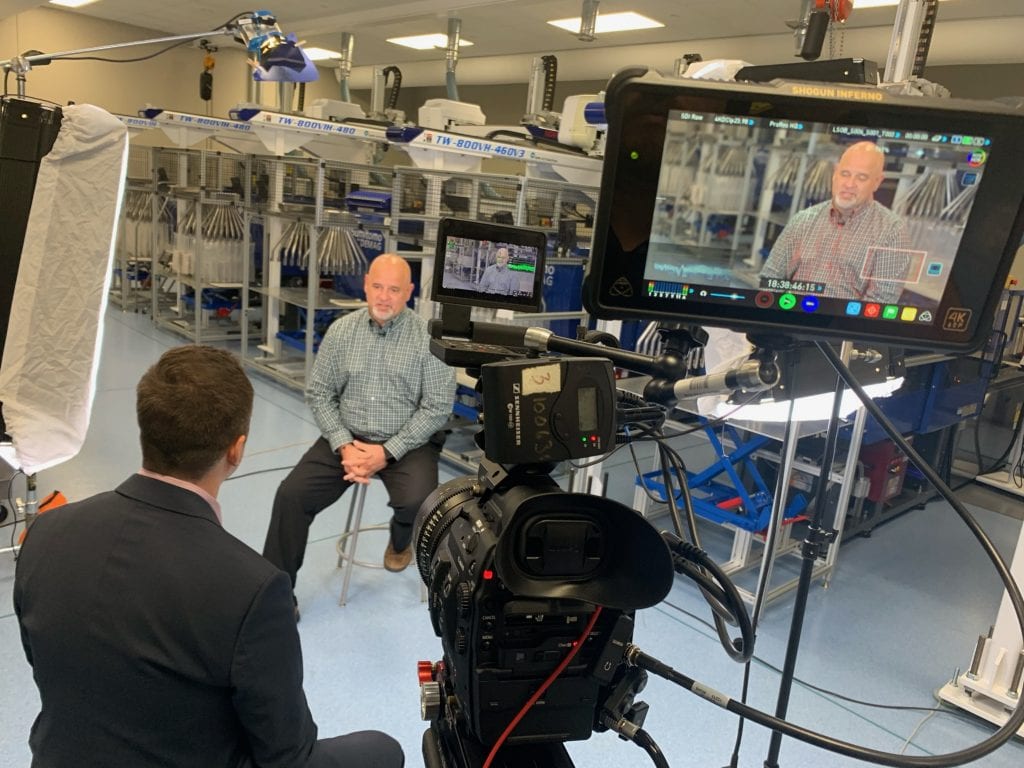With an ever-increasing number of prospects and consumers (including prospective franchisees) engaging with video content more than any other form of media, it has become crucial for franchisors to leverage this powerful tool effectively. Video marketing presents a unique opportunity to maintain brand consistency, attract new franchisees, and enhance operational efficiency within your franchise network. A well-crafted video strategy can serve as a cornerstone for communicating your brand’s values, training new members, and reaching potential franchisees with compelling stories and visuals.
This guide will walk you through the essential steps to develop a comprehensive video strategy tailored specifically for franchisors. We’ll cover critical aspects, including initial planning and goal setting, content creation and production, distribution and promotion, budgeting and resource allocation, measuring success, and more. By following these guidelines, franchisors can create impactful videos that engage their audience, support franchisees, and drive business growth.
Initial Planning and Goal Setting

Determining Goals
The first step in developing a comprehensive video strategy is setting clear goals. These goals will guide your content creation and distribution efforts. Identifying key performance indicators (KPIs) such as engagement rates, click-through rates, and conversion rates will help you measure the success of your video marketing efforts. For instance, a goal might be to increase franchisee leads by 20% within six months through targeted video campaigns. KPIs provide measurable benchmarks to evaluate performance and make data-driven adjustments to your strategy as needed.
Setting Clear Objectives
Effective video marketing begins with setting clear objectives. Each video should have a well-defined purpose that aligns with the overall franchise goals. Defining specific objectives for each video, such as brand awareness, lead generation, or education, helps in creating focused and targeted content that serves its intended purpose efficiently.
Defining the Goals for Each Video: Outline specific objectives for each video, such as brand awareness, lead generation, or education. Clearly defined goals help in creating focused and targeted content that serves its intended purpose efficiently. For example, Rob Glessner advises franchisors to tailor their video goals to different stages of the franchisee journey. Videos aimed at potential franchisees might focus on the benefits of joining the franchise, while training videos for new franchisees can ensure they understand company standards and practices.
Aligning Video Content with Overall Franchise Targets: Ensure that each video supports the broader objectives of the franchise. Whether the aim is to attract new franchisees, provide training, or promote brand consistency, the video content should reflect and reinforce these targets. This alignment ensures cohesive messaging across all marketing channels. By tailoring content to the specific goals of the franchise, videos can effectively contribute to various aspects of business growth and franchise development.
Content Creation and Production



Creating a content calendar can help you plan and schedule your video production efforts. This tool allows you to map out your content strategy over weeks and months, ensuring that you produce a consistent stream of high-quality videos. Consistent branding and high production quality are essential to maintaining a professional image and building trust with your audience. Each video should align with your brand’s visual and messaging standards to reinforce recognition and credibility. Employing professional videographers, editors, and sound designers can elevate the overall quality of your productions.
Building the Content Calendar
A robust content calendar outlines the types of videos, their topics, and the schedule for production and release. This ensures regular content flow and helps in maintaining consistency. A well-structured calendar should detail pre-production, production, and post-production timelines, taking into account significant dates and promotional periods. Consider incorporating different video types such as explainer videos, testimonials, and live streams into the calendar to keep the content diverse and engaging.
To get started, use tools like Google Calendar or project management software such as Trello or Asana, which facilitate collaboration and keep the team on the same page. Regular meetings to review and adjust the content calendar ensure that the video production efforts align with the franchise’s evolving marketing goals. This proactive planning minimizes last-minute rushes and ensures that each video is well-planned, produced, and executed, contributing positively to the overall video marketing strategy.
Ensuring High Production Quality
High production quality is non-negotiable when it comes to professional video marketing. From lighting and sound to editing and graphics, every aspect should be top-notch. By maintaining high standards, you show your audience that you take your brand seriously and are committed to delivering quality content. Quality production reflects a brand’s professionalism and can significantly influence viewers’ perceptions.
Invest in modern, high-quality equipment, and consider working with experienced professionals to handle filming, editing, and post-production processes. Attention to detail in aspects such as proper lighting, clear audio, and seamless editing enhances the video’s overall impact. Consistent visual and tonal quality across videos enforces brand recognition and builds trust among your audience.
Moreover, aligning the video’s production quality with the franchise’s brand guidelines is crucial. This includes using brand colors, fonts, logos, and other visual elements to ensure that every video supports brand consistency. Consistency in visual and messaging helps in establishing a strong brand identity and keeps the audience engaged with familiar and professional-looking content.
Distribution and Promotion



Implementing a multi-channel approach for video distribution ensures that your content reaches a broad audience. Utilizing a mix of social media platforms, email campaigns, and your company website allows you to maximize your reach. Using paid advertising and SEO can further boost the visibility of your videos, driving more traffic and engagement. Paid campaigns on platforms like Facebook and LinkedIn can target specific demographics, ensuring that your videos reach the most relevant audience. Additionally, optimizing video titles, descriptions, and tags with relevant keywords can enhance discoverability on search engines, thus attracting organic traffic.
Multi-Channel Approach
This involves leveraging various platforms such as YouTube, Facebook, Instagram, and email newsletters to disseminate your video content. Each platform has its strengths and caters to different segments of your target audience. For example, YouTube is excellent for long-form content and detailed instructional videos, while Instagram and Facebook are ideal for short, engaging clips. Email newsletters can be used to share exclusive content with current franchisees and keep them engaged.
Consistency across platforms is key; ensure that your brand’s visual and thematic elements are maintained throughout. Cross-promotion between these channels can also help in driving traffic from one platform to another, thereby increasing overall engagement.
Outreach Studios employs a systematic approach by understanding the unique features and audience of each platform to tailor video content accordingly. This strategy not only maximizes reach but also enhances viewer interaction by presenting content in the most suitable format and context for each touchpoint.
SEO and Paid Advertising
Optimizing your videos for search engines and using paid advertisements can significantly increase video visibility. Search engine optimization (SEO) involves using the right keywords, tags, and descriptions to make your video content easily discoverable. This includes incorporating relevant keywords in the video title, description, and tags, as well as transcribing videos for better searchability.
Paid advertising ensures that your videos reach a targeted audience, further increasing engagement and conversions. Platforms like Google Ads and social media networks provide robust targeting options, allowing you to specify demographics, interests, and behaviors to reach the most relevant audience. For instance, demographics-based targeting on LinkedIn can help you reach potential franchisees by focusing on business professionals and entrepreneurs.
Outreach Studios has demonstrated success in leveraging SEO and paid advertising, with testimonial examples showing notable increases in organic and paid traffic for clients. This dual strategy not only helps in reaching a wider audience but also ensures sustained engagement and higher conversion rates.
Budgeting and Resource Allocation



Allocating the right budget and resources is crucial for producing high-quality, impactful videos. Planning should account for all aspects of video production, including pre-production planning, production expenses, and post-production edits. A detailed budget prevents overspending and ensures adequate funding for each project phase. Effectively managing resources, including personnel, equipment, and time, maximizes productivity and output quality.
Planning the Budget
Budgeting comprehensively encompasses scriptwriting, shooting, editing, graphics, and distribution. Detailed budgeting is crucial for balancing quality and cost-effectiveness. Begin by outlining the primary components of your video production process and estimating the associated costs for each segment. This includes pre-production activities such as concept development and scripting, production costs like filming and equipment rental, and post-production expenses including editing, sound design, and graphics.
For instance, knowing the costs for hiring professional videographers, editors, and actors, if needed, can help in setting realistic budget expectations. Allocating budget for unexpected expenses and contingency plans is also advisable. Rob Glessner emphasizes the importance of a flexible yet detailed budget that can adapt to changes without compromising on quality.
Resource Allocation
Effective resource management involves leveraging internal teams and outsourced professionals such as videographers, editors, and marketing specialists. This collaboration enhances production quality and efficiency. Begin by assessing the skills available within your current team and identifying gaps that may require external expertise. For instance, while your marketing team may excel at content ideation and strategy, you might need to hire freelance videographers or a specialized production company for high-quality shoots.
Efficiently managing your resources includes scheduling shoot days to maximize crew and equipment usage, thus reducing costs associated with multiple shoot days. Investing in versatile equipment and software that can be used across various projects can also yield long-term savings. Additionally, Rob suggests employing a project management tool to keep track of tasks, deadlines, and resource allocation, ensuring that everyone involved is aligned and productive throughout the video production process.
The integration of internal resources with external experts not only maintains high production standards but also ensures that the workflow remains seamless and cost-efficient. This hybrid approach supports the creation of high-quality videos while adhering to budget constraints, ultimately contributing to a successful video strategy for franchisors.
Measuring Success



Continuous measurement and adjustments are key to optimizing video marketing efforts. Utilize analytics tools to track the performance of video content. Metrics such as views, engagement rates, click-through rates, and conversion rates provide insights into how well the videos are performing. Regularly reviewing these metrics helps identify successful strategies and areas for improvement. Using feedback from analytics and audience responses to refine and adjust your video marketing strategies is essential for continuous improvement and alignment with franchise goals.
Analytics and Performance Tracking
Utilizing tools like Google Analytics, YouTube Analytics, and social media insights provides valuable data on video performance. This helps in understanding viewer behavior and preferences, enabling data-driven decisions. For instance, Google Analytics can track user interaction on your website, revealing how viewers find and engage with your video content. YouTube Analytics offers detailed metrics about viewer demographics, watch time, and traffic sources, helping you understand which types of content are performing best.
Social media platforms also provide a wealth of insights. Facebook Insights and Twitter Analytics can show engagement metrics such as likes, shares, comments, and retweets, offering a clear picture of how your video content resonates with your audience. These platforms can also help you track the effectiveness of your paid campaigns by showing conversion rates and ROI from advertisements.
Adjusting Strategies Based on Feedback
This iterative process involves refining content based on performance data and audience feedback. Regular reviews and adjustments ensure your content stays relevant and effective. For example, if analytics reveal that viewers drop off after the first 30 seconds of a video, it may indicate the need for a more engaging opening segment. Surveys and direct feedback from viewers can also provide qualitative insights that quantitative metrics might miss, such as why certain content resonates or falls flat.
Adjusting strategies might include tweaking the content format, altering the distribution strategy, or experimenting with new video styles. For example, if short-form videos on Instagram are generating higher engagement than long-form YouTube videos, you might consider reallocating budget and resources to optimize for shorter content. Rob Glessner encourages franchisors to adopt a proactive approach by consistently reviewing performance and being willing to pivot strategies based on what the data reveals.
This dynamic approach ensures that the video marketing strategy not only aligns with franchise goals but also adapts to changing audience preferences and market trends, leading to sustained engagement and improved ROI over time.
Bringing It All Together
Developing a robust video strategy for franchisors involves meticulous planning, high-quality content creation, strategic distribution, and continuous performance evaluation. By adhering to these guidelines, franchisors can create impactful videos that engage their audience, support franchisees, and drive business growth. At Outreach Studios, we offer comprehensive video production services tailored to meet these needs to attract and close franchisees, ensuring a streamlined and effective approach to your video marketing strategy.
Investing in a thoughtful and strategic video marketing approach ensures the alignment of video content with the broader franchise objectives, creating a cohesive and impactful brand narrative.
Contact us today to discuss how we can help you attract and close the right prospects!

